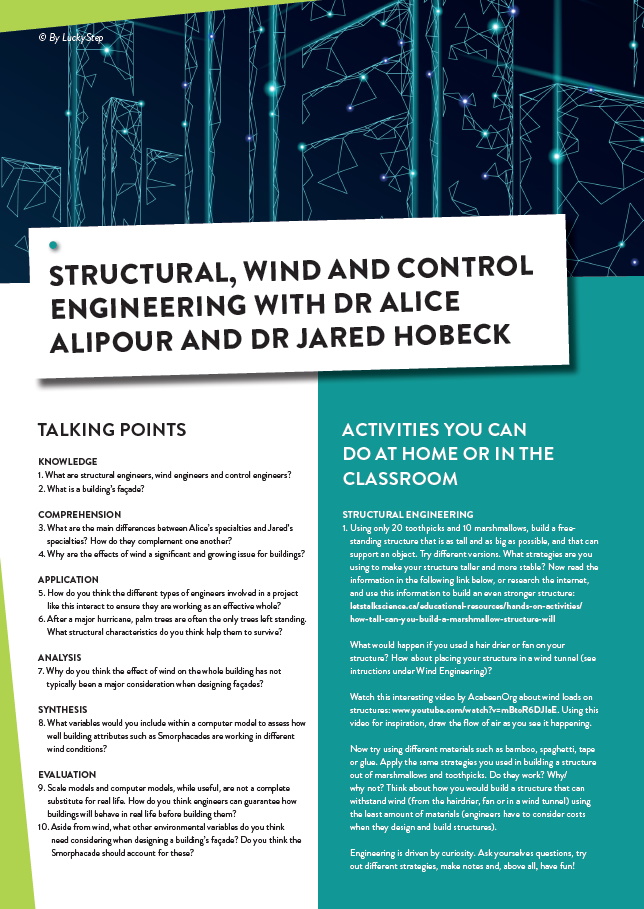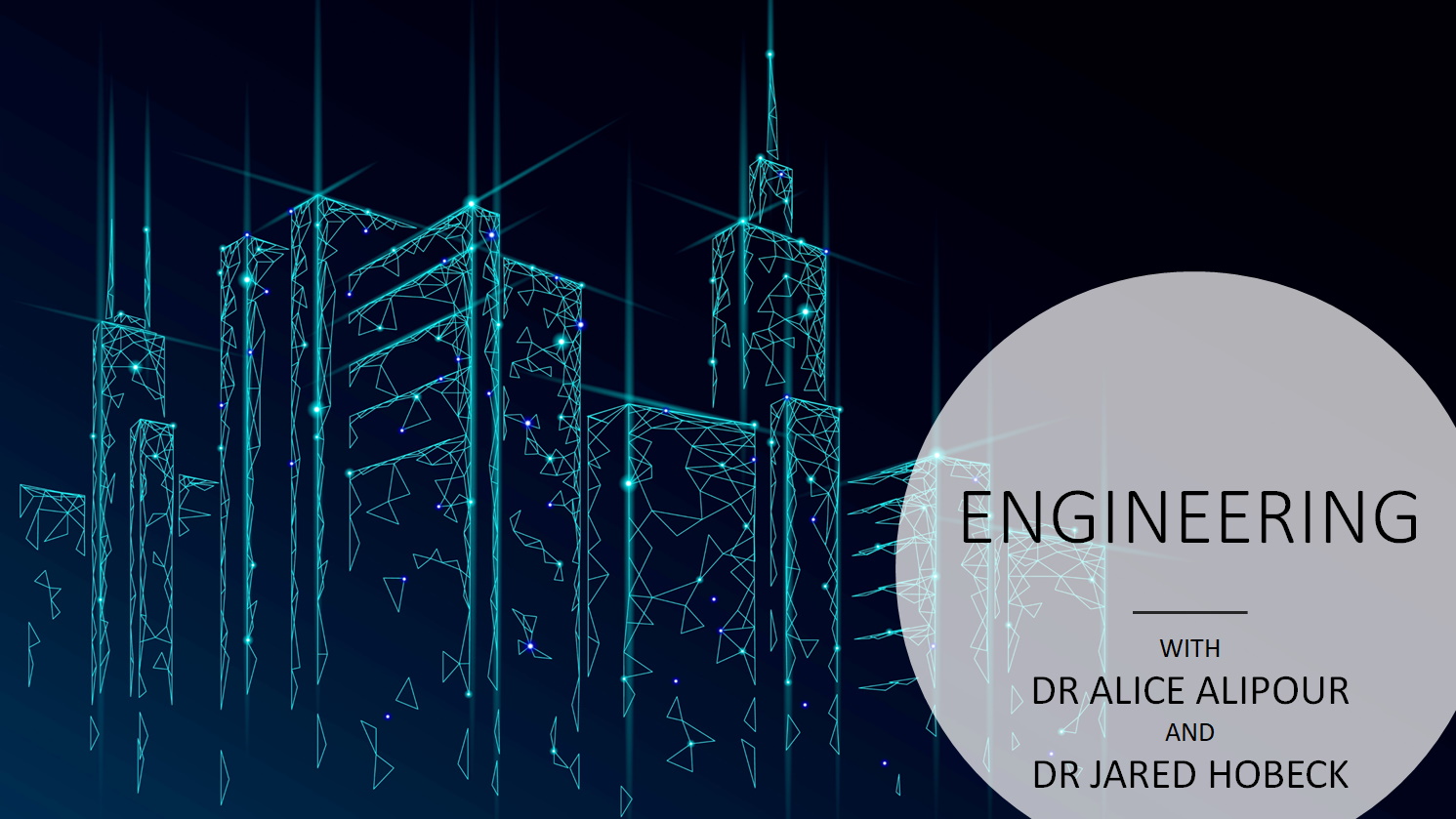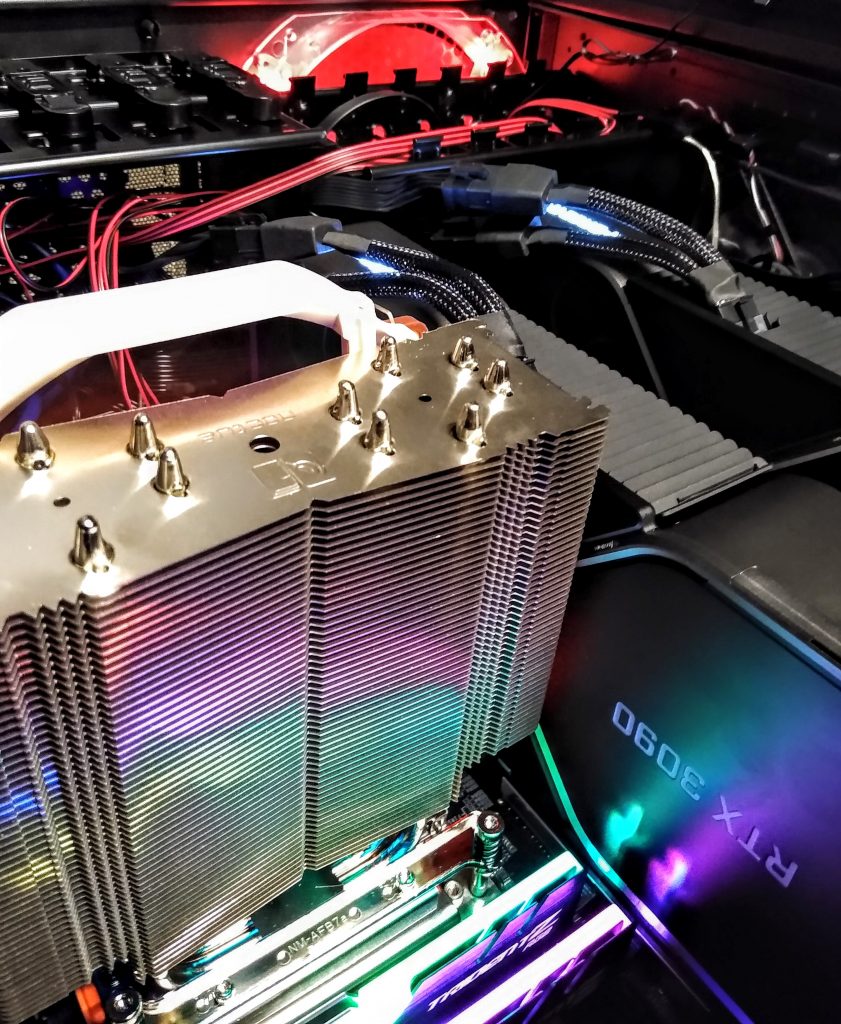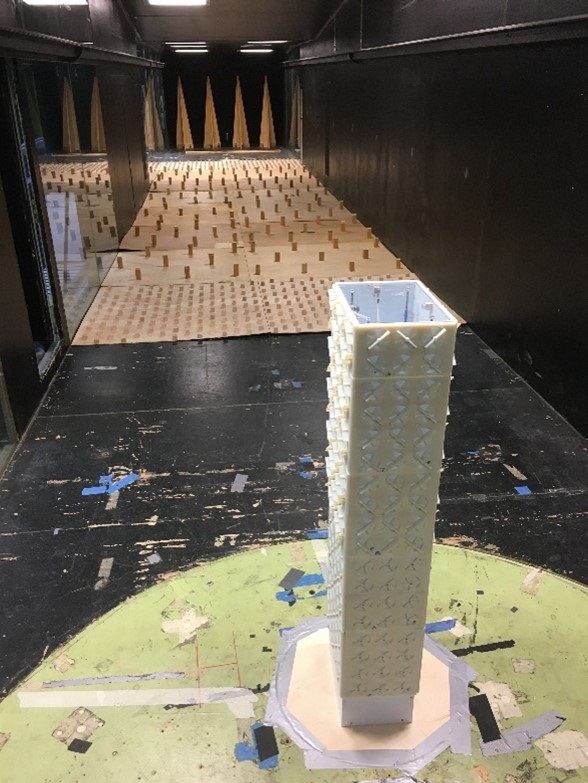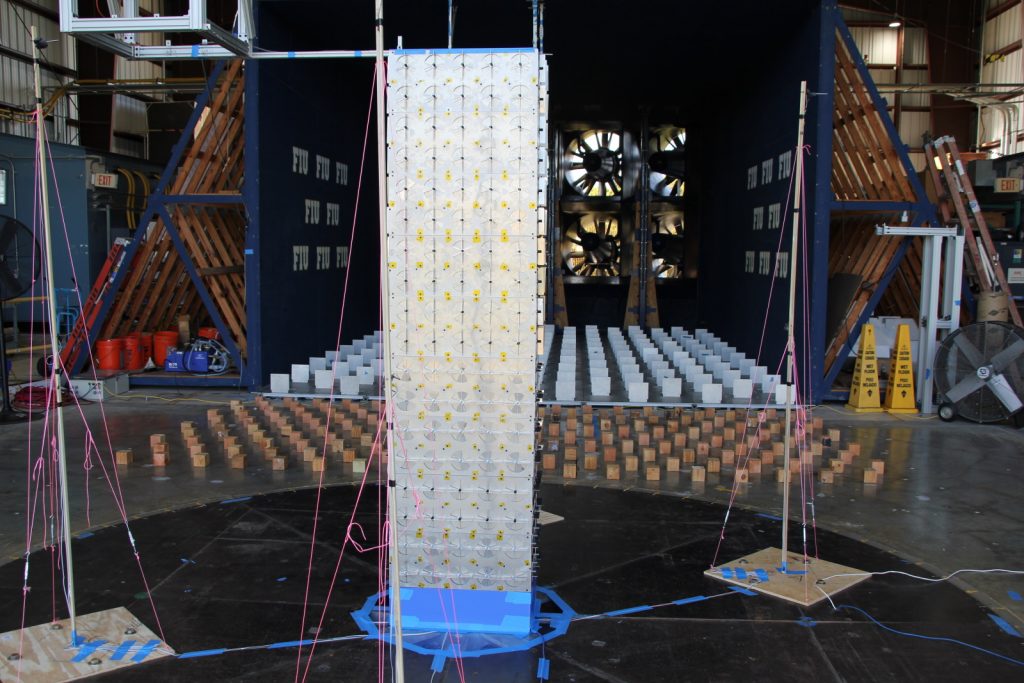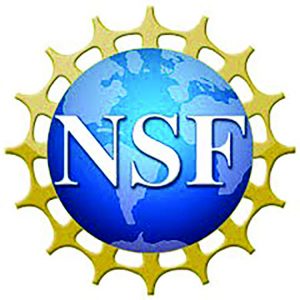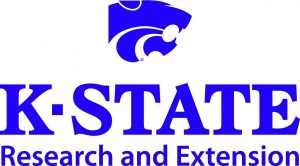Morph with the wind: shape-changing buildings
Storms or hurricanes can damage buildings in a single incident. New engineering efforts at the Iowa State and Kansas State Universities are creating buildings adept at withstanding the effects of wind – not just through designing stronger structural systems, but by enabling the buildings to change their shape to adapt to changing wind conditions
ENGINEERING – AN OVERVIEW
Engineering is a very broad discipline and there are many specialties within it, which overlap with one another. Below are some of the most relevant for this article.
AEROSPACE ENGINEERING – generally involves the design and construction of aeroplanes, jets, gliders, autogyros, helicopters and more, but the skills needed to do this can be applied to other areas. Testing wind loads on various structures is one example
CIVIL ENGINEERING – the design and construction of infrastructure, such as roads, bridges, buildings, railways and utility networks. Structural engineering is a specialism of civil engineering, focusing on designing structures such as buildings bridges
MECHANICAL ENGINEERING – one of the broadest areas of engineering involving control systems, structures, dynamics, fluid dynamics and thermodynamics
The exterior layer of a building – known as its façade – is an important element in its design and functionality. From an architectural standpoint, it is the part of the building that people will see, so its aesthetic traits are important. However, its main function from an engineering perspective is to protect the building from the elements, including the wind. While the impact of wind is considered in façade design, it is now believed the façade could have a much greater role to play in making the whole building as durable as possible, especially as buildings get taller and winds get stronger.
This issue is being addressed through a collaborative effort between Iowa State and Kansas State Universities. A team of engineers from both universities is creating Smart Morphing Façades, “Smorphacades” for short, which actively change their shape to reduce encounters with wind and subsequently wind-induced vibrations on the building. This leads to less stress placed on the underlying structure of the building, and a smaller range of vibrations, which means increased comfort for people inside. The team incorporates engineers from a range of disciplines, who combine their talents to bring the project to life.
THE TROUBLE WITH WIND
“Traditionally, fixed structures such as buildings are designed to be a specific and unchanging shape, with only crude estimates examining how they might respond to wind,” says Dr Alice Alipour, who leads the Iowa State side of the project. Buildings may be designed to be aerodynamic in the direction wind comes from most often, but the labyrinth of streets and buildings in any metropolitan area leads to erratic wind patterns, and these are being exacerbated by a changing climate.
Buildings are also becoming taller and more flexible, as lighter building materials and more sophisticated designs are developed, but wind-induced vibrations only get stronger and more serious with height. “The current solution to controlling this vibration is to place massive weights in buildings’ upper storeys,” says Dr Jared Hobeck, who leads the Kansas State side of the project. However, this solution entails substantial structural reinforcement and other costly measures, and is only effective for specific vibration frequency ranges. As hurricanes and tornadoes become stronger and more common, there are significant risks involved in building tall and heavy buildings, and minimising structural damage is a key concern during the design process.
THE SMORPHACADE
The Smorphacade provides a solution for this issue. It consists of many movable components controlled by motors or similar devices, which perform a function similar to the flaps on a wing of an aircraft. Through changing their angle and position, they can make the building more streamlined in whatever direction the wind approaches from. “Smorphacades will be designed to change either the roughness of the façade, or the aerodynamics of any side of the building,” says Alice.
This proactive shape-changing will require a sophisticated control system, which is where Jared comes in. He is principal investigator for the Smorphacade control system, bringing with him a broad research background involving structures, wind vibration, and data-driven modelling. “The cyber-physical system we are developing uses a combination of wind sensors, optimisation algorithms and artificial intelligence to search for combinations of façade positions and wind flow conditions that limit building vibration,” says Jared. “Over time, the controller builds a ‘memory’ of the positions that work best for any particular wind flow condition.”
SCALE MODELS AND COMPUTER MODELS
Deciphering the exact shape of these devices, how they should be positioned on the building and how they react to different environmental conditions, forms the core challenge of the research project. “We use wind tunnels to test aeroelastic models,” says Alice. “These models are designed to sway and twist in the wind in the same way the full-scale building would.” The models in question are about one-fiftieth to one-hundredth the size of the actual building, but represent the structural characteristics of a full-size building. Air flow in a wind tunnel can be precisely controlled, so the team can see exactly how the scale model responds to different wind patterns.
Jared also performs wind tunnel experiments, developing the network of vibration and pressure sensors that the Smorphacade’s algorithm relies upon to know how to adapt to different wind conditions. While very useful, these experiments can be expensive and time-consuming; therefore, simplified computer simulations can provide an efficient alternative to quantifying interactions.
Alice, with her structural engineering background, builds full scale numerical models of the building’s structural system to examine the impact of the changing wind loads on the building. This requires a detailed understanding of the structural characteristics of the building, including the materials used to build it, the building’s overall framework, and other loads it may encounter. Results from these simulations can then be used to help design the real-world Smorphacade system.
“We are very excited about the prospects of this project,” says Alice. “Our computational models, validated with extensive experimental tests have highlighted that use of morphing facades to change the aerodynamics of the buildings provides a very effective way of reducing the wind-induced vibrations. Along the way we have made major contributions to the state-of-the-art of building design under wind events.”
A BONUS PROJECT AIM
While mitigating wind-induced vibrations is the project’s primary function, the team also intends for the designs to be able to react to other environmental conditions by controlling shading or changing colour to save energy. For example, on hot sunny days, the façade can provide shade and turn a lighter colour to reflect heat from the sun, thereby reducing the energy required for cooling. How ‘cool’ is that?!
Reference
https://doi.org/10.33424/FUTURUM267
ENGINEERING – AN OVERVIEW
Engineering is a very broad discipline and there are many specialties within it, which overlap with one another. Below are some of the most relevant for this article.
AEROSPACE ENGINEERING – generally involves the design and construction of aeroplanes, jets, gliders, autogyros, helicopters and more, but the skills needed to do this can be applied to other areas. Testing wind loads on various structures is one example
CIVIL ENGINEERING – the design and construction of infrastructure, such as roads, bridges, buildings, railways and utility networks. Structural engineering is a specialism of civil engineering, focusing on designing structures such as buildings bridges
MECHANICAL ENGINEERING – one of the broadest areas of engineering involving control systems, structures, dynamics, fluid dynamics and thermodynamics
The exterior layer of a building – known as its façade – is an important element in its design and functionality. From an architectural standpoint, it is the part of the building that people will see, so its aesthetic traits are important. However, its main function from an engineering perspective is to protect the building from the elements, including the wind. While the impact of wind is considered in façade design, it is now believed the façade could have a much greater role to play in making the whole building as durable as possible, especially as buildings get taller and winds get stronger.
This issue is being addressed through a collaborative effort between Iowa State and Kansas State Universities. A team of engineers from both universities is creating Smart Morphing Façades, “Smorphacades” for short, which actively change their shape to reduce encounters with wind and subsequently wind-induced vibrations on the building. This leads to less stress placed on the underlying structure of the building, and a smaller range of vibrations, which means increased comfort for people inside. The team incorporates engineers from a range of disciplines, who combine their talents to bring the project to life.
THE TROUBLE WITH WIND
“Traditionally, fixed structures such as buildings are designed to be a specific and unchanging shape, with only crude estimates examining how they might respond to wind,” says Dr Alice Alipour, who leads the Iowa State side of the project. Buildings may be designed to be aerodynamic in the direction wind comes from most often, but the labyrinth of streets and buildings in any metropolitan area leads to erratic wind patterns, and these are being exacerbated by a changing climate.
Buildings are also becoming taller and more flexible, as lighter building materials and more sophisticated designs are developed, but wind-induced vibrations only get stronger and more serious with height. “The current solution to controlling this vibration is to place massive weights in buildings’ upper storeys,” says Dr Jared Hobeck, who leads the Kansas State side of the project. However, this solution entails substantial structural reinforcement and other costly measures, and is only effective for specific vibration frequency ranges. As hurricanes and tornadoes become stronger and more common, there are significant risks involved in building tall and heavy buildings, and minimising structural damage is a key concern during the design process.
THE SMORPHACADE
The Smorphacade provides a solution for this issue. It consists of many movable components controlled by motors or similar devices, which perform a function similar to the flaps on a wing of an aircraft. Through changing their angle and position, they can make the building more streamlined in whatever direction the wind approaches from. “Smorphacades will be designed to change either the roughness of the façade, or the aerodynamics of any side of the building,” says Alice.
This proactive shape-changing will require a sophisticated control system, which is where Jared comes in. He is principal investigator for the Smorphacade control system, bringing with him a broad research background involving structures, wind vibration, and data-driven modelling. “The cyber-physical system we are developing uses a combination of wind sensors, optimisation algorithms and artificial intelligence to search for combinations of façade positions and wind flow conditions that limit building vibration,” says Jared. “Over time, the controller builds a ‘memory’ of the positions that work best for any particular wind flow condition.”
SCALE MODELS AND COMPUTER MODELS
Deciphering the exact shape of these devices, how they should be positioned on the building and how they react to different environmental conditions, forms the core challenge of the research project. “We use wind tunnels to test aeroelastic models,” says Alice. “These models are designed to sway and twist in the wind in the same way the full-scale building would.” The models in question are about one-fiftieth to one-hundredth the size of the actual building, but represent the structural characteristics of a full-size building. Air flow in a wind tunnel can be precisely controlled, so the team can see exactly how the scale model responds to different wind patterns.
Jared also performs wind tunnel experiments, developing the network of vibration and pressure sensors that the Smorphacade’s algorithm relies upon to know how to adapt to different wind conditions. While very useful, these experiments can be expensive and time-consuming; therefore, simplified computer simulations can provide an efficient alternative to quantifying interactions.
Alice, with her structural engineering background, builds full scale numerical models of the building’s structural system to examine the impact of the changing wind loads on the building. This requires a detailed understanding of the structural characteristics of the building, including the materials used to build it, the building’s overall framework, and other loads it may encounter. Results from these simulations can then be used to help design the real-world Smorphacade system.
“We are very excited about the prospects of this project,” says Alice. “Our computational models, validated with extensive experimental tests have highlighted that use of morphing facades to change the aerodynamics of the buildings provides a very effective way of reducing the wind-induced vibrations. Along the way we have made major contributions to the state-of-the-art of building design under wind events.”
A BONUS PROJECT AIM
While mitigating wind-induced vibrations is the project’s primary function, the team also intends for the designs to be able to react to other environmental conditions by controlling shading or changing colour to save energy. For example, on hot sunny days, the façade can provide shade and turn a lighter colour to reflect heat from the sun, thereby reducing the energy required for cooling. How ‘cool’ is that?!
PURSUING A CAREER IN ENGINEERING
– Different engineering degrees have different requirements, but a strong background in mathematics is almost always beneficial, followed by physics, chemistry and computer science.
– The scope and scale of engineering brings with it good job prospects. Jared says the majority of his students have a job offer before they graduate with their bachelor’s degree.
– There are lots of websites outlining the wide range of engineering careers. For example, the Institute of Structural Engineers provides a breakdown of what structural engineers do, and includes an engaging video: www.istructe.org/become-a-structural-engineer/what-isan-engineer
– This is Engineering helps make the link between solving world challenges and the breadth of careers in engineering: www.thisisengineering.org.uk
– According to Salary.com, an engineer in the US can earn between $64,820 to $159,490, though Jared points out that this can be dependent on many factors, such as location, type of industry, experience and qualifications.
MEET SOME OF THE ENGINEERS!
The Smorphacade project involves a unique collaboration between structural engineers, wind engineers and control engineers, each of whom has their own integral role:
– Structural engineers understand building dynamics and ensure that plans meet current design requirements. They analyse the effects of reduced wind load on their buildings’ underlying structure and assess buildings’ performance and predicted life-cycle cost.
– Wind engineers understand interactions between building dynamics and flow conditions. They characterise wind loading, and how it differs with or without the Smorphacade, such as through testing scale models.
– Control engineers develop algorithms that can process information from sensors, and develop an active control mechanism that allows the Smorphacade to be adjusted as wind patterns around the building change.
Alice, Jared, and members of their team explain more about their own roles within the project, and what led them to where they are today. The project involves professors, PhD students, postgraduates and undergraduates.
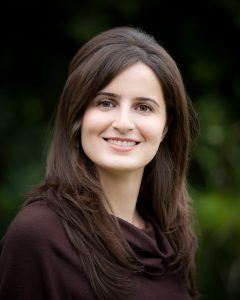
DR ALICE ALIPOUR
Joel and Judy Cerwick Professor; Associate Professor, Civil, Construction and Environmental Engineering, Iowa State University
ROLE: Lead Principal Investigator at Iowa State University and creator of the Smorphacade idea. Alice conducts performance-based designs and testing of scale models of tall buildings fitted with Smorphacades.
WHAT INSPIRED YOU TO GET INTO ENGINEERING?
I have always been interested in math and physics, and as a child I was mesmerised by the construction sites of buildings and bridges. When I was old enough to enter college, engineering seemed a natural choice.
WHAT EXCITES YOU ABOUT THIS PROJECT?
The Smorphacade approaches the problem of wind affecting structures from a completely different perspective, by addressing the problem from its core. It will not only enhance the resilience of buildings but also help save energy, contributing to sustainability efforts. It should be a win-win development for the design of tall buildings.
WHAT LED YOU TO STUDY CIVIL ENGINEERING?
Natural hazards engineering is a major interest of mine, and has been the focus of much of my education and research. By studying the impacts of natural hazards on the built environment, we can modify the design of buildings and structures to improve the resilience of communities exposed to these hazards.
YOU ARE INVOLVED IN WISE (WOMEN IN STEM EDUCATION), SCIENCE BOUND (FOR STUDENTS OF COLOUR), AND THE EARTHQUAKE ENGINEERING RESEARCH INSTITUTE STUDENT CHAPTER. WHY ARE YOU PASSIONATE ABOUT THESE PROGRAMMES?
I am a true believer in diversity within the design and management of our built environment. The infrastructure we build should serve everyone in society, so we need a workforce that reflects the society we serve.
WHAT DRIVES YOUR PASSION FOR MENTORING?
I have always thrived on offering close mentorship and support to a diverse group of students. In particular, I have found involving them in research and professional development activities to have a lasting impact on their careers.
Never stop dreaming. The world’s most challenging problems need people who can think outside the box.

DR PARTHA P. SARKAR
Professor, Department of Aerospace Engineering; Department of Civil, Construction, and Environmental Engineering (courtesy), Iowa State University
ROLE: Design, build, and test the Smorphacade, to evaluate its performance in mitigating wind vibrations of a building. This involves testing a scaled model in a wind tunnel, facilitating structural analysis, and selecting the most effective configurations.
WHAT EXCITES YOU ABOUT THE SMORPHACADE PROJECT?
I enjoy the opportunity to test the bold concept of a smart building façade that can morph and modify itself in real time. In nature, tall trees bend and fold their leaves to reduce their aerodynamic drag in high winds. Developing a man-made building that can dynamically react to wind in a similar way is an exciting challenge.
YOU HAVE RECENTLY BEEN NAMED A FELLOW OF THE AMERICAN SOCIETY OF ENGINEERS AND A FELLOW OF THE STRUCTURAL ENGINEERING INSTITUTE. WHAT DO THESE ACCOLADES MEAN TO YOU?
To qualify for these fellowships, I had to show significant contributions to research, education and outreach in my areas of expertise, as well as service to these societies and involvement in other professional activities. My long-standing membership of both organisations and strong support from my colleagues helped me earn these distinctions. These awards mean the whole world to me because they recognise my accomplishments and contributions to my profession, which I am so proud of.
WOULD YOU RECOMMEND A CAREER IN ENGINEERING?
I certainly would. Through innovation, analysis, design and building, engineers solve a multitude of the technical, environmental and social problems that the world faces. There are different disciplines within engineering depending on one’s skills and interests. Jobs are abundant, average salaries are great and there is a good growth prospect. Tomorrow’s engineers will face many challenges to solve, related to climate, change, cybersecurity and population growth.
TOP TIP
Engineering requires a strong background in science and math, problem solving, and sometimes hands-on skills. I recommend sharpening these skills early on in high school, which will also help you recognise where your talents and interests lie. Read up on different engineering disciplines, what they entail, and what they can achieve.
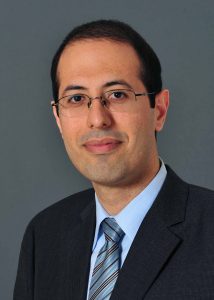
DR BEHROUZ SHAFEI
Joel and Judy Cerwick Professor; Associate Professor, Department of Civil, Construction, and Environmental Engineering; Department of Materials Science and Engineering, Iowa State University
ROLE: Systematically study how buildings equipped with Smorphacades can be configured to give strong structural performance alongside mitigating the risk of wind hazard. This involves ensuring new building systems meet code-specified requirements and are optimised in terms of material and construction efficiency.
WHAT IMPACT WILL THIS PROJECT HAVE?
The proposed Smorphacades introduce a radical transformation in how buildings are designed and configured to resist extreme wind events. This cutting-edge innovation will have a lasting positive impact on the safety and performance of buildings in areas prone to severe hurricanes and tornadoes.
HOW DID YOU CHOOSE WHICH AREA OF ENGINEERING TO STUDY AT UNIVERSITY?
My BSc focused on civil engineering, which included components of structural engineering. After graduating, I decided to focus on structural engineering for my MSc and PhD, to pursue my passion for the performance and risk assessment of structures.
WOULD YOU RECOMMEND A CAREER IN ENGINEERING?
Yes, for sure. Engineering is a broad domain with several disciplines that can directly contribute to improving the quality of our built environment. There are ample opportunities to follow your own area of interest, such as through focusing on theoretical or hands-on experimental work.
TOP TIP
Get involved in research projects as early as you can, even at high school if possible. Personally, early engagement helped me establish my own research career. Research also helps you learn how to think systematically, an important skill for problem-solving, both in engineering and elsewhere in life.
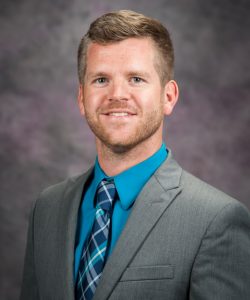
DR JARED HOBECK
Burk-Ice Keystone Research Scholar, Assistant Professor of Mechanical Engineering, Director of the Multifunctional Structures Lab, Alan Levin Department of Mechanical and Nuclear Engineering Kansas State University
ROLE: Principal Investigator at Kansas State University. Jared develops the Smorphacade control system and actuator mechanisms. He also designs, builds and tests aeroelastic building models outfitted with a Smorphacade system.
WHAT SKILLS DO YOU BRING TO THIS PROJECT?
My background is in multidisciplinary research, including multifunctional structures, system dynamics, flow-induced vibration and data-driven modelling.
WHAT EXCITES YOU ABOUT THIS PROJECT?
I am excited by the multidisciplinary nature of this project, and the challenge associated with developing a controller for such a complex and highly dynamic system.
DID YOU ALWAYS WANT TO BE AN ENGINEER WHEN YOU WERE YOUNGER?
No, though science was my favourite topic in school. I did not enjoy math, but was excited to see what could be accomplished with it, and understood its necessity within engineering. My academic career happened almost by accident. I had no interest in graduate school until a particular research project during my undergraduate studies, no interest in a PhD until I started my master’s, and no interest in becoming a professor until towards the end of my PhD.
YOU WERE INTERVIEWED BY FOX TELEVISION ABOUT YOUR RESEARCH ON PIEZOELECTRIC GRASS. WHAT IS PIEZOELECTRIC GRASS?
Piezoelectric grass is artificial grass made with a unique material (piezoelectric ceramic) that produces a voltage when it bends.
DO YOU THINK IT IS IMPORTANT FOR SCIENTISTS TO COMMUNICATE TO THE PUBLIC, SUCH AS THROUGH TV OR RADIO?
Yes. I think any mechanism that introduces young people to STEM or shares knowledge with society is important. Gathering knowledge only to keep it to oneself is worthless.
TOP TIP
Never feel limited by your situation, and don’t worry about making big career plans. Just pursue your interests one step at a time. Be prepared for those interests to change, and follow them as they do, even if the challenges you face seem too big. The reward is usually much bigger.
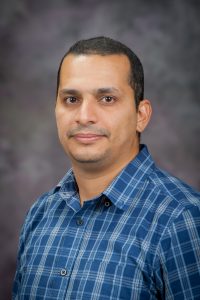
KHALID ABDELAZIZ
PhD Candidate and Graduate Research Assistant, Multifunctional Structures Lab, Alan Levin Department of Mechanical and Nuclear Engineering, Kansas State University
ROLE: Develop computer simulation models and Smorphacade control algorithms.
WHAT SKILLS DO YOU BRING TO THIS PROJECT?
I have experience with computational modelling and simulation techniques, engineering optimisation and machine learning. My background involves both academia and industry. During this project I have started learning about many more areas, and I believe my ability to learn new skills is my most important talent.
WHAT MOTIVATES YOU TO WORK ON THIS PROJECT?
At first, I was excited by the innovative nature of the idea, but was also concerned about its feasibility. As I kept working, I grew increasingly motivated by positive signs from our initial simulation studies and our preliminary experimental studies. Now we know the Smorphacade is feasible, we are trying to make it as effective and practical as possible.
WHAT DID YOU WANT TO BE WHEN YOU WERE YOUNGER?
I think in some form I always wanted to be a researcher, but this only became clear during my master’s degree when I started doing scientific research. My personality always revolved around finding better solutions to the status quo. Being a researcher allows me to do just that while also making a living.
WHAT LED YOU TO STUDY MECHANICAL ENGINEERING?
I learned web design and computer programming in my early high school days, and was hired as a junior web developer not long after. I first majored in computer science, the logical choice, but found it uninteresting since I already knew its contents. My mother advised me to switch to another field where my knowledge could be useful, so I picked mechanical engineering because I also adored machines. That advice from my mother shaped my future in ways I could never imagine.
WOULD YOU RECOMMEND A CAREER IN MECHANICAL ENGINEERING?
I would. It is one of the most versatile engineering disciplines, and has a function within virtually every industry. The discipline also fosters analytical thinking and a problem-solving mindset, that can help make one’s daily life more organised.
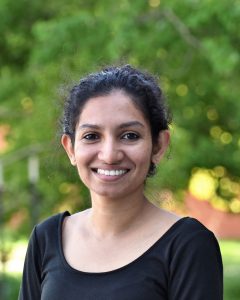
SMRITHI HAREENDARAN
PhD student, Department of Civil, Construction and Environmental Engineering, Iowa State University
WHAT SKILLS DO YOU BRING TO THE TEAM?
I am a structural engineer and proficient in analysis and design software and the codes and standards needed for the design of steel and concrete buildings. This enabled me to develop a novel analytical framework for the structural performance assessment of tall buildings under extreme wind loads. I also have knowledge of machine learning that helps me implement deep learning techniques for the prediction of buildings’ structural behaviour under wind loads.
DID YOU ALWAYS WANT TO BE AN ENGINEER WHEN YOU WERE YOUNGER?
When I first considered university, I wanted to be an architect, because I was interested in the aesthetics of structures. As I was finishing school, I realised I was also very interested in analytical problem-solving, and so pursued civil engineering, as this combined both my creative and problem-solving interests.
HOW DID YOU CHOOSE WHICH AREA OF ENGINEERING TO STUDY?
During my bachelor’s degree in civil engineering, my favourite subjects always involved structural analysis and design. In my final year I worked on the development and design of a reinforced concrete bridge. I thoroughly enjoyed this project and was eager to learn more, which led to me pursuing a master’s and PhD in structural engineering.
WOULD YOU RECOMMEND A CAREER IN STRUCTURAL ENGINEERING?
Yes, I certainly would! A structural engineer is often involved in highly creative and multidisciplinary projects, working in areas such as the energy, industrial, or green building sectors. It is a highly innovative career which can provide opportunities to give back to the community, such as through involvement in sustainability-based design projects.
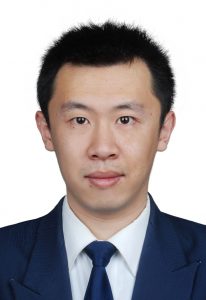
FANGWEI HOU
PhD student, Iowa State University
ROLE: Design and perform a series of wind tunnel tests to validate the effectiveness of the Smorphacade system.
YOU HAVE BEEN AWARDED THE REX AWARD FOR OUTSTANDING RESEARCH ACCOMPLISHMENTS. WHAT HELPED YOU TO ACHIEVE THIS RECOGNITION?
I think hard work and passion for the work I was doing helped me get the award. I greatly appreciated the support of Dr Sarkar and Dr Alipour on my research; without them, I would not have got the award.
WHY DID YOU CHOOSE TO STUDY AEROSPACE ENGINEERING?
I chose aerospace engineering for my undergraduate degree because I dreamed that one day I could become an aircraft designer. I like how engineering can help us solve real-world problems.
Be creative. Engineers are always solving problems, and creativity is a vital component of this.
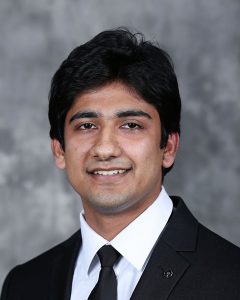
DIKSHANT SAINI
Postdoctoral Scholar, Iowa State University
WHAT WILL THE SMORPHACADE ENABLE ENGINEERS TO DO?
The Smorphacade is an interesting concept. We normally design buildings to be a specific shape, but this is not always effective at mitigating wind vibrations given that wind speed and direction is constantly varying. With the Smorphacade, engineers will be able to optimise buildings’ shapes to weather any storm, through reducing the wind-induced vibrations of the buildings.
WHAT SKILLS DO YOU BRING TO THIS PROJECT?
I have a strong background in structural dynamics and mechanics. During my PhD, I voluntarily learnt concepts that directly integrate into the Smorphacade project, such as wind engineering and flow aerodynamics.
WHY DID YOU CHOOSE TO STUDY CIVIL ENGINEERING?
I chose to study civil engineering and specialised in structural engineering during my PhD. When I was young, my dad would take me and my sister to visit the aqueducts in my city, to show how the river passes through the canals and tunnels. I was intrigued by the design and its function, and this began a lifelong interest in the discipline.
WOULD YOU RECOMMEND A CAREER IN CIVIL ENGINEERING?
Without a doubt. A civil engineer can directly help communities to protect themselves against natural or man-made hazards. Civil infrastructures such as bridges, buildings, and waterways are fundamental to a nation’s growth and economy.
RESEARCH EXPERIENCES FOR UNDERGRADUATES
Research Experiences for Undergraduates (REUs) are competitive summer research programmes aimed at undergraduates studying science, engineering and mathematics in the US. REUs are sponsored by the National Science Foundation and are hosted in various universities across the country, including Iowa State University and Kansas State University.
Iowa State University has a newsletter, which will keep you up to date on undergraduate research opportunities and events:
www.undergradresearch.iastate.edu/for-students/summer-research-opportunities
The university also lists REU opportunities in the US.
Kansas State University’s Carl R. Ice College of Engineering offers undergraduate students the chance to be part of its engineering research activities across the college: engg.ksu.edu/research/undergraduate
MEET UNDERGRADUATE STUDENTS WORKING ON THE SMORPHACADE PROJECT
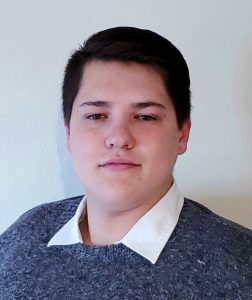
MICHAEL HUNTLEY
Undergraduate student, Department of Aerospace Engineering, Iowa State University
I enjoy applying what I learn in the classroom to real-world problems and tasks. Real-world challenges rarely have a known solution or exact answer, so I must apply the skills I acquired to solve the problem, alongside a bit of ingenuity.
When I was in my junior year of high school, I was undecided about what I wanted to study at university. I eventually settled on aerospace engineering after I became interested in aerodynamics, specifically the aerodynamic design of vehicles.
I enjoy the learning process. The more time I spend at university, the more I realise how much there is I don’t yet understand. I am still undecided what I will do after I graduate in the spring of 2022. I am considering pursuing a postgraduate degree in mechanical engineering, or going directly into industry. My decision will depend on the job offers I receive, the schools I am accepted into, and the financial aid packages these schools offer.
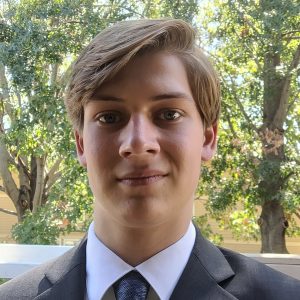
BRETT FUNK
Undergraduate student, Department of Mechanical and Nuclear Engineering, Kansas State University
This project combines many different aspects of mechanical engineering, such as fluid dynamics, structural mechanics and control systems. I am excited about the opportunity to bring these all together in a way that will have an impact on the real world.
I chose mechanical engineering due to the breadth of topics it covers. I wanted an engineering discipline that would give me the tools I needed to solve a wide variety of problems. By building a foundation in materials, fluids, thermodynamics, electronics and more, my studies in mechanical engineering are preparing me for the diversity of problems present in the world.
I enjoy the opportunity to apply my studies to physical projects and see the effects. Between undergraduate research and design team involvement, there are ample chances for me to apply what I have learned and gain hands-on experience.
After I finish my degree, I hope to find a career in the aerospace industry. I am fascinated by space exploration and the challenges it presents. I would love to be a part of finding solutions to further humanity’s understanding of the universe.
Do you have a question for the team?
Write it in the comments box below and the team will get back to you. (Remember, researchers are very busy people, so you may have to wait a few days.)


